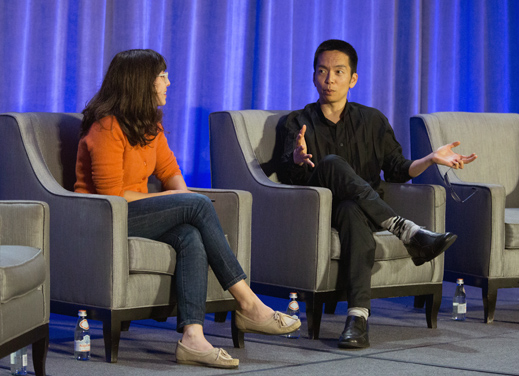EmTech Digital: Design Is What Differentiates Tech Companies Today
Dominant tech companies such as Google, Facebook, and Apple are frequently described as battling to build better technology or hire the best programmers. John Maeda of venture capital firm Kleiner Perkins Caufield and Byers believes that they and other big corporations now also fight on a newer front: design.

“That is the differentiator for companies today,” said Maeda, speaking at MIT Technology Review’s EmTech Digital event in San Francisco Tuesday. He trained as a computer scientist before becoming an influential graphic designer, academic, and author. Maeda joined KPCB in 2013.
Design has grown to become a key part of the decision-making process that leads to the creation of new technology products, whether they are software or hardware, said Maeda. Companies that understand the power of design understand that it is concerned with much more than just superficial aesthetics, he said.
“In actuality design is not really about how it looks—it’s about the system thinking that went into [a product],” he said. How design teams are organized inside a corporation—for example, whether they report to the CEO or to product and engineering managers—has become a critical question for large technology companies, said Maeda. One of his primary activities at KPCB is to help the firm’s portfolio companies organize and make use of their design teams more effectively.
In recent years Google, Apple, and Microsoft have all boasted of efforts to use broad, design-led thinking to reinvent their operating systems and other products. Facebook set up a design lab to craft experimental products such as the Paper news reading app (see “Paper Will Make You Want to Read News on Facebook”).
Making design a more expansive and important tool leaves less room for the stereotypical mercurial genius that many people think of when they hear the word “designer.”
“The way design used to be it was about being the person with extreme OCD [obsessive compulsive disorder] tastes. Design in tech is not like that, it’s a team sport and it’s a more analytical thing and the stakes are higher,” said Maeda. “When you design for tech you’re designing for millions of people–that kind of person doesn’t get to be an insert-expletive-word-hole.”
When asked to point to a technology company that demonstrates how that approach to design can pay off, Maeda picked one that makes cars, not gadgets. “People bring up Apple, but Tesla’s the best example out there right now, I think,” he said. “It’s such a clever company that produces a great car experience.”
Maeda predicted that the way Tesla and the leading Internet companies have embraced design would soon become standard across many industries. As evidence he cited how management consultants McKinsey last month acquired Lunar, a design agency whose clients have include Apple and HP. Spanish bank BBVA bought design firm Spring Studio a month before that, Maeda noted: “All these companies are acquiring design firms; it has value.”
Keep Reading
Most Popular
Large language models can do jaw-dropping things. But nobody knows exactly why.
And that's a problem. Figuring it out is one of the biggest scientific puzzles of our time and a crucial step towards controlling more powerful future models.
How scientists traced a mysterious covid case back to six toilets
When wastewater surveillance turns into a hunt for a single infected individual, the ethics get tricky.
The problem with plug-in hybrids? Their drivers.
Plug-in hybrids are often sold as a transition to EVs, but new data from Europe shows we’re still underestimating the emissions they produce.
Stay connected
Get the latest updates from
MIT Technology Review
Discover special offers, top stories, upcoming events, and more.